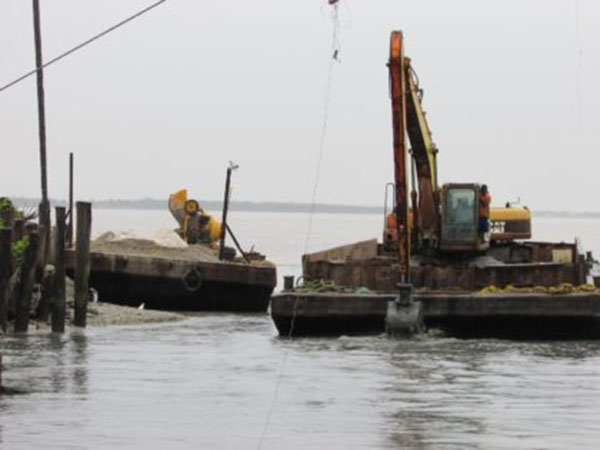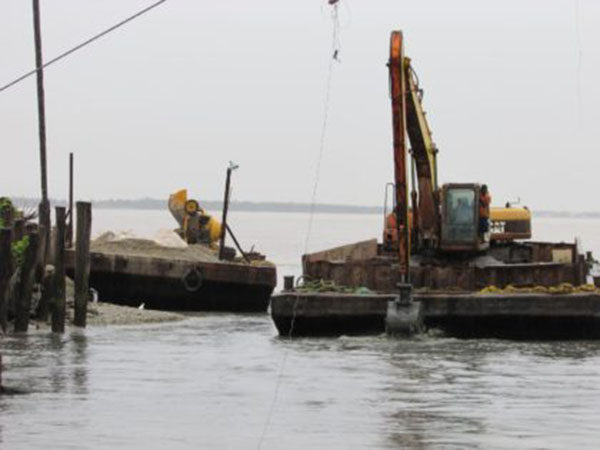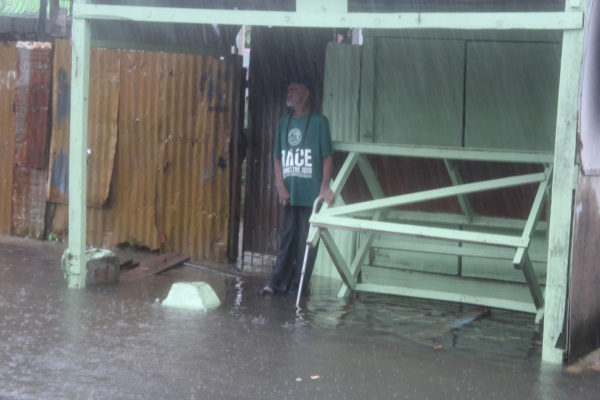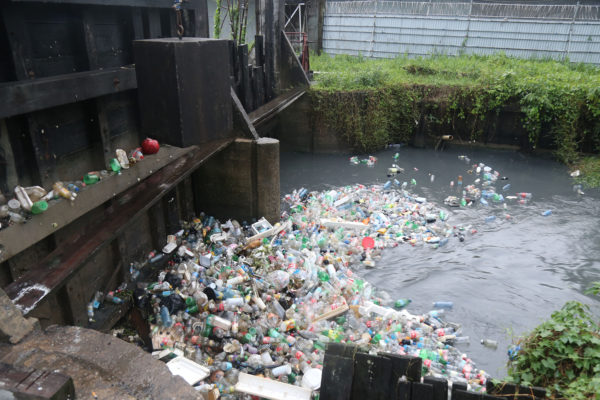Government and the city were jolted into reality yesterday after intense and prolonged rain coincided with the spring tide, flooding the capital for hours and exposing the danger of dependence on kokers.
While pumps sprang into action, two key ones were not working, raising continuing questions about the city’s management of infrastructure during the rainy season. Yesterday’s flooding was the biggest challenge of its type to the APNU+AFC government and the city since the two completed a wide array of projects meant to ease flooding in the capital.
Georgetown was not prepared to handle the level of rain which fell yesterday and even if the city was prepared there would still have been flash flooding in several areas since the drainage infrastructure is only able to properly manage half that amount of water.
This was explained to Stabroek News by Chief City Engineer Colvern Venture. Venture noted that while the city drainage system is designed to drain up to 2.5 inches of water within a 24 hour period, the city received about 4 inches of water between 2 am to 1 pm yesterday.
According to information released by the Hydrometeorological Office between the hours of 8 am and 11 am yesterday the city received almost 3 inches of rainfall by 2pm that level of rainfall had been doubled.
A press release just after noon from the Hydromet said that “based on the latest model output and satellite data; please note that we are anticipating 12 hours rainfall accumulation between 25.0 mm and 100.0 mm, however some areas in Regions 2 to 4 may likely exceed this total. Recent rainfall has made the ground wet and additional rain will bring the potential for flooding/water accumulations over some areas.”
Venture also explained that the majority of the rainfall occurred during high tide making it impractical for the city to utilize its 12 sluices to prevent water accumulation, as a result the city was forced to turn to the hydroflow pumps, two of which were not working.
“There are five pumps but the Lamaha pump went down yesterday after a piece of wood became caught in its impeller and the Riverview pump has been down for a little while as it was clogged by garbage and several parts damaged,” Venture said. At approximately 7 pm last evening the Lamaha pump had been repaired while the Riverview pump was still not functioning. Members of the City Engineer’s Department are currently working to repair this pump as soon as possible, hopefully by today.
Venture along with a technical team from City Hall spend yesterday monitoring the flood within the city while an operation room was set up at City Hall to receive information from the public.
In a press statement yesterday afternoon, City Hall explained the situation in a similar manner and called for residents to ensure that the waterways were free from garbage which would restrict their capacity to hold storm water and reduce the flow to outfall channels. The also appealed to homeowners to “re-think the amount of spaces they concrete in their yards” as this was preventing water from being absorbed by the soil.
Also in the field yesterday was Minister of Public Infrastructure David Patterson. The minister along with a team from his ministry conducted a physical assessment of pumps in Georgetown to determine measures which could be implemented to offer relief to flood affected residents.
In a release the Ministry noted that due to the inoperable pumps, several additional pumps will be provided to assist city hall in draining the city.
“Two pumps will be installed later tonight [last night] at Muneshwer’s and Sussex Street while two smaller pumps will be deployed in Georgetown including the Queenstown area. These pumps will operate while works are being carried out to the inoperable pumps,” the ministry explained.
Both MoPI and City Hall made sure to mention that the high volume of rain was recorded during the spring tide.
“Concerns were raised on the ongoing high tide and the effects it could have on the flood intervention efforts. While normally sluices can be opened for up to six hours, with the high tide in effect, this time is cut down to about three hours,” the MoPI statement said.
However just after 3 pm when the tide receded it became necessary for the outfall channels of several sluices to be desilted.
“Excavators have been deployed to the Cummings Canal, the Cowan Street Canal, and the Downer Street Canal. The Civil Defence Commission (CDC) is also in Albouystown, East Ruimveldt, and West Ruimveldt where emergency relief works are ongoing,” the same statement explained.
Venture later noted that these issues were further compounded at the Ruimveldt sluice by a large volume of garbage which was limiting the outflow. He however noted that in the absence of more rainfall “everything should be back to normal at the next low tide.”
“We opened the sluices at 3 and are trying to keep them open as longs as possible. hopefully until 9 pm (last night),” Venture said.
A check by Stabroek News at around 8 pm found that the water had receded from most of central Georgetown though areas such as Albouystown still had significant levels of water.








